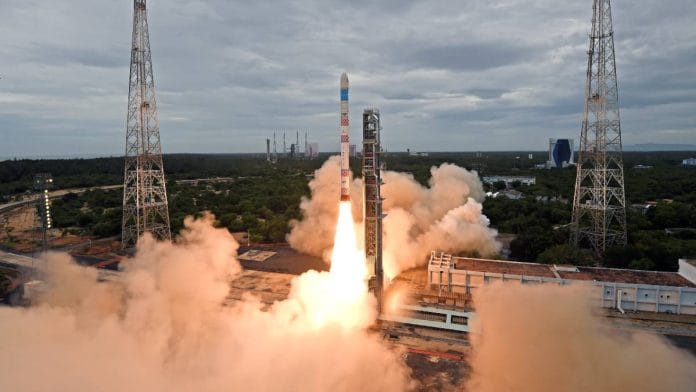New Delhi: With the launch of the third and final development flight of the Small Satellite Launch Vehicle (SSLV) — the Indian Space Research Organisation’s (ISRO’s) smallest launch vehicle — the SSLV Development Project will finally be complete. This will allow the Indian industry and NewSpace India Limited (NSIL), a public sector undertaking under the Department of Space, to launch commercial satellites using the vehicle.
The SSLV development flight 3 (SSLV-D3) mission will lift off into space with Earth Observation Satellite EOS-08 at 9.17 am on 15 August from the Satish Dhawan Space Centre in Sriharikota, ISRO announced Tuesday.
What are the capabilities of the SSLV and how many missions have been conducted so far? ThePrint explains.
Also read: Scientists from IITs, TIFR, IITM-Pune in list of first Rashtriya Vigyan Puruskar awardees
A 3-stage vehicle that can ‘launch on demand’
SSLV is a three-stage launch vehicle. It has three solid propulsion stages and a terminal stage. The first three stages use solid propellants as fuel.
The terminal stage is equipped with a liquid propulsion-based Velocity Trimming Module (VTM) and a payload adapter. The VTM helps reduce the velocity of the launch vehicle when necessary, while the payload adapter connects the payloads to the top stage of the rocket.
The rocket has a diameter of 2.1 metres and a length of 34 metres, with a liftoff mass of approximately 120 tonnes. It has multiple satellite mounting options for nanosatellites, microsatellites, and mini-satellites.
The SSLV can “launch on demand”, which will help ISRO cater to the emerging small satellite launch services market.
The SSLV can carry a single satellite weighing up to 500 kg to a 500-kilometre planar orbit and launch six to eight missions every year. Also, it can also carry three different satellites ranging from 10 to 300 kg to a 500-km planar orbit.
Meanwhile, the rocket can carry payloads weighing up to 500 kg till low-Earth orbit (LEO), and payloads up to 300 kilograms till Sun-synchronous orbit (SSO).
The rocket is different from other generations of launch vehicles developed by ISRO — Satellite Launch Vehicle-3 (SLV-3), Augmented Satellite Launch Vehicle (ASLV), Polar Satellite Launch Vehicle (PSLV), Geosynchronous Satellite Launch Vehicle (GSLV), and GSLV Mark III. This is because these mainly cater to national developmental needs and have enabled ISRO to develop and master critical technologies related to solid, liquid, and cryogenic propulsion systems.
The key features of SSLV are that it offers a low-cost option for space launches; flexibility in accommodating multiple satellites; ‘launch-on-demand’ capabilities; low turnaround time (the time taken to complete the launch process); minimal launch infrastructure requirements; and faster production from industries.
Also, the SSLV has minimum launch pad occupancy. The vehicle can be integrated and launched within 24 hours.
History of SSLV missions
The first SSLV development flight, known as SSLV-D1, was launched on 7 August 2022 and carried satellites Microsat 2A and AzaadiSAT.
However, it failed to place them into the intended circular orbit. This was because ground control teams had failed to identify a sensor failure, according to ISRO.
The second SSLV development flight, known as SSLV-D2, was launched on 10 February 2023 and successfully placed satellites EOS-07 (Earth Observation Satellite-07), Janus-1, and AzaadiSAT-2 into a 450-kilometre orbit.
Carrying EOS-08 into space
The SSLV-D3 will carry EOS-08 to a 475-kilometre circular orbit with an inclination of 37.4 degrees. EOS-08 is equipped with three payloads that will perform surveillance, environmental monitoring, disaster monitoring, volcanic activity observation, fire detection, and industrial and power plant disaster monitoring.
The satellite weighs about 175 kg and can generate power of around 420W.
In June this year, NSIL and Australia-based aerospace firm Space Machines announced at the India Space Congress that the first dedicated commercial mission of SSLV will be conducted in 2026. As part of this mission, SSLV will place Space Machines’s Optimus spacecraft, the largest spacecraft designed and built by Australia so far, into orbit.
The mission, called MAITRI (Mission for Australia-India’s Technology, Research, and Innovation), will help strengthen ties between Australia and India in the space sector and focus on debris management and sustainability.
(Edited by Sanya Mathur)






